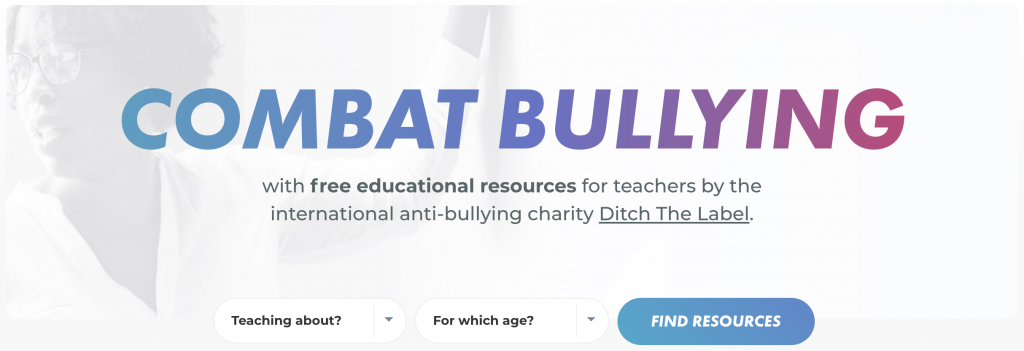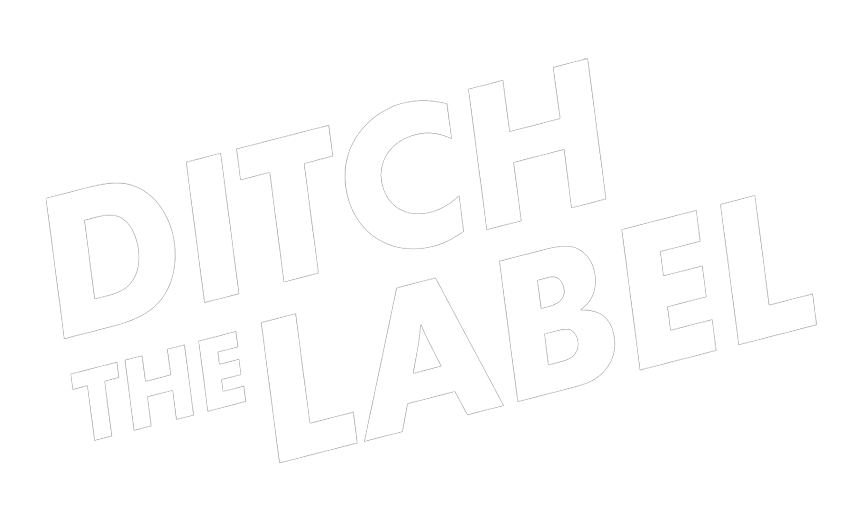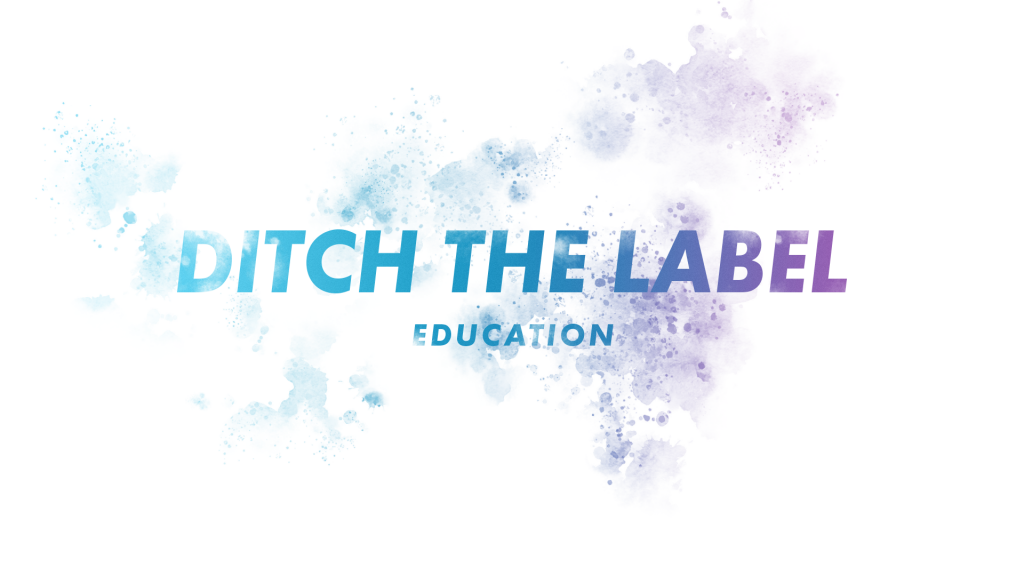Anti Bullying Resources for Teachers
Ditch the Label are proud to offer free teaching resources for teachers to help tackle bullying and its root issues.
Our education website www.dtled.org hosts a whole programme of lessons for students aged 11-18 which focus on key areas such as bullying, gender stereotypes and digital literacy.
We’ve included some highlights below, as well as two exclusive assemblies which are only available here…
Lessons:
Here are a selection of lessons from our Education Programme that address bullying and why it happens:
Behind the Bully
This lesson explores the root causes of bullying behaviour and encourages students to reflect on why people feel the need to bully others. It pushes high ability students to consider potential methods of combating bullying through tackling the root causes.
Don’t @ Me
This lesson asks students to examine their own online behaviours and understand the consequences of some of their actions. It allows them room to explore the subjectivity of cyberbullying behaviour and reinforces their responsibilities regarding their behaviour towards others online.
What you looking at?
This lesson encourages students to explore their own behaviour when it comes to witnessing bullying and offers them guidance and encouragement to intervene in bullying situations, when appropriate.
Assemblies:
These assemblies are a great way to kickstart conversations around bullying in your school. They can be delivered by teachers or students as part of Anti-Bullying Week or at any time of the year.
Challenging Attitudes
A fully scripted assembly which challenges current attitudes and approaches to bullying, through analysis of current data.
Debunking the Myths
A fully scripted assembly which explores the myths which surround bullying, and what people can do to deal with some of the issues they might face.
Visit The Education Website
For more resources on bullying and much more, check out our education website dtled.org. Our lessons on bullying, digital literacy and gender stereotypes include everything from how to destress, to the impact of social media on self-esteem, and how gender stereotypes affect careers.
The resources are all completely free, digital and available for teachers across the country to download.
Anti-Bullying Week 2019
Anti-Bullying Week 2019 runs between Monday 11th November – Friday 15th November 2019.
Our research shows that 1 in 2 young people will, at some point, experience bullying. As a result, 1 in 3 will self-harm, grades will drop and 14% will develop eating disorders. Getting students engaged in activities, assemblies and lessons can be a really effective way to start conversations about bullying and the impact it can have.
We recommend a whole week of activities to generate school engagement around bullying.
- Monday: Anti-Bullying Week Assembly
- Tuesday: All students participate in The Annual Bullying Survey
- Wednesday: Lunch-time fundraising activities
- Thursday: PSHE lesson on Bullying
- Friday: Tutor-time anti-bullying activity
The Annual Bullying Survey
Taking part in The Annual Bullying Survey makes for an ideal activity during Anti-Bullying Week.
It is the largest annual benchmark of bullying in the UK and each year, secondary schools, high schools and colleges from across the country take part, enabling us to better understand the dynamics and nature of bullying.
Students will need approximately 30 minutes to participate in the online survey, and we highly recommend that ALL your students take part.
Click here to register your interest
Fundraising Activities
As part of Anti-Bullying Week, many schools choose to run fundraising activities to fund vital support for those who are experiencing bullying. Or learn more about our flagship Anti-Bullying Week Fundraiser – Give It Up for Ditch the Label.
Here are 5 ways your school could get involved and raise money for Ditch the Label or download a printable version to use in your classroom this Anti-Bullying Week.
- Go silent – give up your voice for the day in return for sponsorship. We know nearly 50% of young people who are bullied never tell anyone, not a teacher, not a parent, not a friend – everything you raise will help us reach more young people affected by bullying and give them back their voice.
- Get active – organise a sports match & charge an entry fee. Football, netball, rugby, volleyball, whatever you like playing. You could even go for a staff v student match to for the ultimate grudge match! If everyone pays an entry fee it’s a really simple way to raise funds for Ditch the Label.
- Go on a (digital) holiday – give up technology to raise sponsorship. At Ditch the Label, we’re all about the digital, but we know that a digital detox can sometimes give people a much-needed break from social media. Whether it’s for a day, or for a whole week, it’s a great way to raise money.
- Hold a pop-up shop – refresh your wardrobe and raise money. Ask everyone to have a clear-out and donate their once loved items to a pop-up clothes shop. Give your favourite old clothes the chance to be loved again – and raise money for us in the process.
- Keep it classic – the most common fundraisers can be the most successful. For example, a non-uniform day and a cake sale are really easy and simple ways to get your school involved in fundraising.
(Not enough ideas? Check out another 96 on our 101 fundraising ideas here: https://dtl-staging.org/2020/101-fundraising-ideas/)
More Anti-Bullying Week Activities
If you’re not looking for full lesson plans or assemblies, here are a selection of other activities which you could use this week.
1. Help students understand the hidden part of bullying (30 mins)
We know from our extensive work with young people that nobody is ever born with an intent to bully others. Bullying is often a behaviour that is used to cope with a traumatic and stressful situation – it could be that the student is having a difficult time at home or is being bullied themselves elsewhere. Those who bully tend to have low self-esteem and confidence issues and just want to be accepted. We would never call anybody a ‘bully’ because it certainly isn’t their identity, it is just a behaviour that needs to change.
We’ve produced an emotional video to encourage students to think differently about bullying and to build their understanding as to some common reasons why people bully. Start the activity by showing the video and follow it with a discussion about the key themes in the video, opening up to the bigger picture: exploring key reasons why people bully others.
– Click here for the video
– Click here for more reasons why people bully others
2. Use Ditch the Label statistics in a quiz (30 mins)
Each year, we produce some of the most comprehensive research papers surrounding the issue of bullying and related factors. This activity is designed to help students understand the landscape of bullying and to encourage them to speak up about issues that are bothering them.
The activity should take approximately 30 minutes, which includes a discussion of the results afterwards.
– Click here for the question sheet
– Click here for the answer sheet
Alternatively, you can direct your students to our research area, they can pick a research paper and create their own quiz based on the statistics in their chosen report.
3. Create a poster, using less than 140 characters (30 mins)
This activity works best in conjunction with a starter activity – such as the Ditch the Label Quiz, this is because it will equip students with a better understanding of bullying and will act as an icebreaker and will fuel inspiration. Students are given the task of designing a new anti-bullying poster for your school. The catch? They are not allowed to use more than 140 characters on their poster, so they need to choose their words wisely. This can be done either in pairs or as a group task.
This activity can also be run as a school/college-wide competition with the winning entry being produced and displayed around the school.
– Examples of posters
4. Teach students to reprogram their stress (50 mins)
Stress is the number 1 killer and is something that troubles us all. We know that bullying massively increases the amount of stress young people face, which can go on to impact grade performance, health and general moods. We have developed a tool to help students rationalise and reduce stress in a simple, digestible way.
This task should be done in pairs only. Each person should need approximately 15-20 minutes to talk about things that are bothering them, and with the help of their partner – better rationalise and deal with those issues. With time to complete the entire task, introduction and evaluation afterwards – this task would typically take 50 minutes.
– Click here to download instructions and the packs
5. Take part in The Annual Bullying Survey (20 mins)
Each year, we work with schools and colleges across the country to help them better understand the landscape and extent of bullying within their environment. We produce The Annual Bullying Survey, which is the most comprehensive annual benchmark of bullying in the UK.
The survey is conducted online and will survey students on their experiences of bullying, whilst exploring their wider social lives, experiences and attitudes. Taking part is completely free and it takes students approximately 20 minutes to complete the survey.
– Click here to find out more information
6. Use role-play (30 mins)
This activity works particularly well in conjunction with activity 1 and could be used as a tool to further explore the reasons why people bully others.
Task students to work in small groups to role-play different bullying-related scenarios and then invite the rest of the class to give their feedback and advice on how to deal with the situations. Examples include:
- Example 1: Student A is sending Student B abuse on Instagram. Student C sees the abuse but isn’t really sure what to do. The issue continues in school when Student A encourages Student C to say nasty things to Student B.
- Example 2: Student A is having a difficult time at home – their parents are arguing a lot and their pet just passed away. In response, Student A feels angry and has nobody to talk to. They take their anger out on Student B and is disruptive in class. Student C, who is a friend of Student A witnesses everything. What could they do to help?
7. Create a list of top tips (30 mins)
This activity works particularly well in conjunction with activities 1 and 2. Ask students to work in pairs or small groups to come up with their top 10 tips on how to overcome bullying. Ask the students to share their tips with the rest of the class.
You will find that there will be a lot of repetition and overlap, so as the facilitator, note down the top 10 most commonly used tips and then use them to produce a classroom charter.

Join our Community
We have a growing online community where young people can anonymously log in and share their problems. On the Ditch the Label community there are opportunities for people to speak to and share advice amongst themselves as well as speaking directly with a trained digital mentor.
The service is absolutely free and operates as a judgement-free zone.
Why not spend the last 10 mins of your lesson encouraging your students to take a look around?
Sorry, the comment form is closed at this time.















Pingback: Anti-bullying Resources – Expanding Access and Inclusion